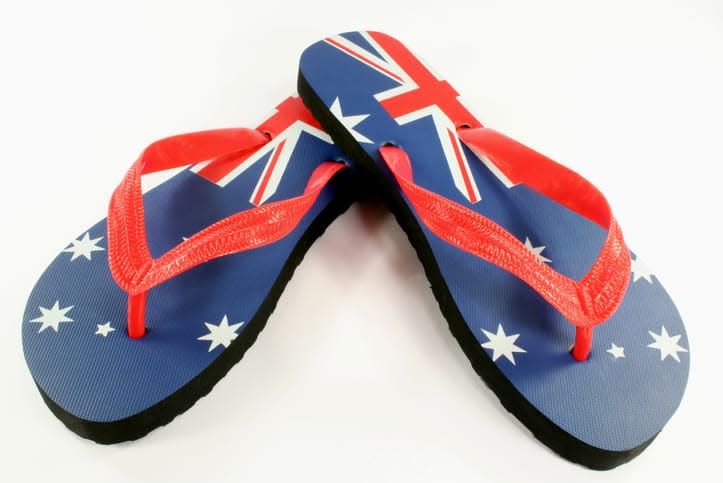The Australian flag. It dances on the wind above Parliament House in Canberra, is raised when our Olympians stand on the podium and, since 1911, has been the saluting flag of the Australian Army at reviews and ceremonial parades.
But increasingly, you’ll also see it merchandised – printed on a pair of thongs, a T-shirt, keyrings or underwear.
“There’s something rather schizoid about a nation that simultaneously promotes the use of the Australian flag as a kind of logo, much like Benetton, Coca-Cola or XXXX, and yet insists that it’s a sacred symbol,” says Graeme Davison, Emeritus Professor of History at Monash University.
This is only possible, he says, because of a shift in how we relate to the flag, including the way in which it’s often worn now, draped over the shoulders of right-wing agitators or people celebrating Australia Day.
“The Australian flag has, I think, become a symbol of personal identity for many people; it’s become their flag rather than their country’s flag, and when that happens there’s a disconnection from the values it traditionally represented,” he says.
“At the turn of the century, the Australian flag was very important to people, but it was something that you put up a flag pole and you saluted. It was something outside yourself to which you owed allegiance. Now, increasingly, the flag is something that you wear. You put it on a T-shirt and so it becomes part of you.
“We’re inclined more and more, I think, to connect ourselves to the nation in this kind of narcissistic way. And it can, of course, have an ugly side. If I’m wearing the flag, I can be gesturing towards other people who we think are not as Australian as we are.”
The most extreme recent example of this occurred on 11 December 2005, at what became known as the Cronulla Riots.
The racially-motivated riots were sparked by a confrontation between a group of Lebanese and lifeguards on North Cronulla beach one week earlier.
By midday on Sunday 11 December, about 5000 people had gathered at Cronulla after more than 270,000 text messages were transmitted inciting the confrontation, with many of those taking part either wearing or waving Australian flags, shouting racist taunts and fighting.
Self-styled far-right “patriots” wore and waved the Australian flag on St Kilda Beach earlier this year, too, at a protest against Africans in Melbourne, goose-stepping and raising their hand in a Nazi salute, flaunting protocols that state the flag should be handled carefully and with dignity and respect.
Flag protocols
There are strict rules and protocols surrounding the use of the Australian flag, outlined in the Australian Flags booklet, and for which the Department of the Prime Minister and Cabinet is responsible.
Among them, the flag should never be:
- allowed to fall or lie upon the ground
- used to unveil monuments or plaques, or cover tables/seats
- flown when in damaged, faded or dilapidated condition
- flown upside down, even as a signal of distress
- flown from the same flag pole as another flag.
- There is no rule to say it cannot be worn.
You can, however, use images of the flag for commercial purposes without permission, but it shouldn’t be defaced by overprinting with words or illustrations and “should be used in a dignified manner and reproduced completely and accurately”.

Right or thong: should we really be stepping on the flag?
A little history
The Australian flag we associate with today, the defaced Blue Ensign with the Union Jack in the canton, and the Commonwealth Star and the Southern Cross, was the result of a public competition held shortly after Federation in 1901 that attracted 32,832 entries.
Annie Dorrington, Ivor Evans, Leslie Hawkins, Egbert Nuttal and William Stevens may not be household names, but their designs, remarkably similar, were the winning submissions. They were announced as such on 3 September 1901 by prime minister Edmund Barton.
The criteria upon which the winning flag designs were judged was: loyalty to the Empire, Federation, history, heraldry, distinctiveness, utility and cost of manufacture.
Loyalty to the Empire!
The relevance of this reference on Australia’s flag now, as depicted by the Union Jack, is lost on some, including Melissa Castan, the Deputy Director of the Castan Centre for Human Rights Law at Monash University.
“I think the Australian flag is a classic Australian anachronism. It’s captured by some imagery that’s from way in the past. The actual pictures that are on the flag do not have to stay consistent for a flag to still represent those important things.
“I think it’s high time we got rid of some of the ancient and somewhat irrelevant overseas artefacts that are residing there, and embrace some modern imagery that really takes account of the diversity and the community and the cohesion in Australia.”
“I think it’s high time we got rid of some of the ancient and somewhat irrelevant overseas artefacts that are residing there, and embrace some modern imagery that really takes account of the diversity and the community and the cohesion in Australia,” she says.
Of the 53 independent nations of the British Commonwealth, four have never had the Union Jack on their flag, and 44 have removed it, including Canada in 1965 and South Africa in 1994.
In 2013, Fiji announced plans to change its flag, which features the Union Jack, but three years later abandoned that idea. New Zealand, whose flag bears a strong resemblance to Australia’s, held a two-stage referendum on a flag change in 2015 and 2016. Voters chose to retain the current flag, 56.6 per cent to 43.1 per cent.
Read more: Australian identity: what does it mean to you?
Conflict confusion
Historically, there has been some debate and misinformation about Australia’s official flag, and so under which flag Australians fought during 20th-century conflicts. The truth is they fought under all of them – the Union Jack, the Red Ensign and the Blue Ensign.
The Blue Ensign was intended for official and Royal Australian Navy purposes, while the Red Ensign was the official flag for Australian-registered merchant ships. Historically, the Red Ensign was also used by civilians on land and was taken onto battlefields by soldiers.
Confusion over the use of the flags was resolved with the Flags Act 1953, which proclaimed the Blue Ensign as the Australian national flag.
But for how long?
Davison says before Australia can seriously rethink the symbols that best represent it, such as a new flag or Australia Day, it first needs to engage in debate around issues such as a republic and a treaty with Indigenous Australians.
“A new flag should embrace some more contemporary imagery, although a successful one might draw on images, like the Southern Cross, that have a long history of association with the country and are of significance to Indigenous as well as non-Indigenous Australians,” he says.
“I recall a discussion some time ago about the idea of just taking the Union Jack out of the present flag and substituting the Aboriginal flag. Something like that might work, although I'd hope perhaps for a more integrated design.
“The key point I'd make, however, is the same one as I make about Australia Day – that the problem is not … the symbol, it's the story.
“The logical remedy for current discontents is not a republic, but a treaty. Conceivably they might come together sometime, but an Australian republic without a treaty won't do – at least that's how I see it now.”






